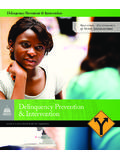Transcription of Risk Factors for Delinquency: An Overview
1 1 MichaelShader, ,isaSocialScienceProgramSpecialistintheO fficeofJuvenileJusticeandDelinquencyPrev ention s(OJJDP s) ,themultiplicativeeffectwhenseveralriskf actorsarepresent, ,thejuvenilejusticefieldhasadoptedanappr oachfromthepublichealtharenainanattemptt ounderstandthecausesofdelinquencyandwork towarditsprevention(Farrington,2000;Moor e,1995).Forexample,themedicalcommunity seffortstopreventcancerandheartdiseaseha vesuccessfullytargetedriskfactors(Farrin gton,2000).Toevaluateapatient sriskofsufferingaheartattack,adoctorcomm onlyasksforthepatient smedicalhistory,familyhistory,diet,weigh t,andexerciselevelbecauseeachofthesevari ableshasaneffectonthepatient , ,ifayouthpossessescertainriskfactors, (2000)callsthisrecentmovementtowardthepu blichealthmodelthe riskfactorparadigm, thebasicideaofwhichisto identifythekeyriskfactorsforoffendingand toolpreventionmethodsdesignedtocounterac tthem (Farrington,2000:1).
2 Althoughmuchoftheresearchonriskfactorsth atyouthfacehasfocusedonpredictingserious andviolentoffenses, ,explainswhytheyareimportant, Factors for Delinquency: An Overview2 What Is a Risk Factor?Risk Factors have been broadly defined as thosecharacteristics, variables, or hazards that, if presentfor a given individual, make it more likely that thisindividual, rather than someone selected from thegeneral population, will develop a disorder (Mrazek and Haggerty, 1994:127). Kazdin andcolleagues (1997) note that a risk factor predicts anincreased probability of later offending. A recentreport from the Surgeon General morespecifically defines a risk factor as anything thatincreases the probability that a person will sufferharm (Office of the Surgeon General, 2001(chapter 4)).
3 Psychologists Coie and colleagues (1993) noted thefollowing regarding risk Factors :2 Dysfunction has a complicated relationshipwith risk Factors ; rarely is one risk factorassociated with a particular disorder. Theimpact of risk Factors may vary with thedevelopmental state of the individual. Exposure to multiple risk Factors has acumulative effect. Many disorders share fundamental risk Steps of the Risk Factor ApproachMercy and O Carroll (1998) summarize the foursteps of the public health approach todecisionmaking as follows: Public health surveillance ( , developing andrefining data systems for ongoing analysis anddisseminating data). Riskgroup identification ( , identifyingindividuals at greatest risk of disease or injuryand the places, times, and other circumstancesassociated with increased risk).
4 Riskfactor exploration ( , analyticallyexploring the potentially causative risk Factors ). Programimplementation and evaluation ( ,designing, implementing, and evaluatingpreventive measures based on an understandingof the population at risk and the community sidentified risk Factors ).The criminal justice field adopted these steps for itsrisk factor approach. Criminologists compilestatistics on the prevalence of crimes through theFBI sUniform Crime Reportsand the Bureau ofJustice Statistics National Crime VictimizationSurvey. They then apply the techniques of riskgroup identification to crime as they attempt todetermine those at greatest risk of justice researchers explore risk Factors byapplying theoretical models and statisticaltechniques to determine which risk Factors arelinked to crime.
5 The criminal justice sector thenworks to develop, design, and implement programsthat attempt to prevent offending. These programsare then evaluated to determine whether they aresuccessful and cost researchers use risk Factors to detect thelikelihood of later offending, many youth withmultiple risk Factors never commit delinquent orviolentacts. A risk factor may increase theprobability of offending, but does not makeoffending a conclusions couldbedrawninthe juvenilejustice field regarding delinquent Factors for Delinquency: An Overview3 What Is a Protective Factor?Research on risk Factors for delinquency hasprompted discussion and investigation intoinfluences that may provide a buffer between thepresence of risk Factors and the onset ofdelinquency.
6 These buffers are known asprotective Factors . Pollard, Hawkins, and Arthur(1999:146) note that protective Factors are thosefactors that mediate or moderate the effect ofexposure to risk Factors , resulting in reducedincidence of problem behavior. Rutter (1987)believes that protective Factors offset the onset ofdelinquency via four main processes: reducing risk,reducing negative chain reactions, establishingself-esteem and self-efficacy, and opening disagree about what constitutes aprotective factor. Protective Factors have beenviewed both as the absence of risk and somethingconceptually distinct from it (Office of theSurgeon General, 2001 (chapter 4)). The formerview looks at risk and protective Factors asopposite ends of a continuum.
7 For example,excellent performance in school might beconsidered a protective factor because it is theopposite of poor performance in school a knownrisk factor. The second view of protective factorssees them as characteristics or conditions thatinteract with risk Factors to reduce their influenceon violent behavior (Office of the SurgeonGeneral, 2001 (chapter 4)). For example, poverty isoften seen as a risk factor, but the presence ofsupportive, involved parents may mediate thenegative influence of poverty to lessen a youth schance of becoming Study Risk Factors ?Several juvenile justice researchers have linked riskfactors to delinquency (Hawkins et al., 1998;Lipsey and Derzon, 1998), and many have alsonoted a multiplicative effect if several risk factorsare present.
8 Herrenkohl and colleagues (2000)report that a 10-year-old exposed to six or morerisk Factors is 10 times as likely to commit a violentact by age 18 as a 10-year-old exposed to only onerisk , the age range or developmental periodduring which a youth is exposed to a specific riskfactor is important to individuals working to tailorprevention programs to specific : A Report of the Surgeon General(2001(chapter 4)) elaborates:Violence prevention and interventionefforts hinge on identifying risk andprotective Factors and determining when inthe course of development they emerge. Tobe effective, such efforts must beappropriate to a youth s stage ofdevelopment. A program that is effective inchildhood may be ineffective inadolescence and vice versa.
9 Moreover, therisk and protective Factors targeted byviolenceprevention may be different fromthose targeted by intervention programswhich are designed to prevent therecurrence of study of risk Factors , therefore, is critical to theenhancement of prevention programs that frequentlyhave limited staffing and funding. Identifying whichrisk Factors may cause delinquency for particularsets of youth at specific stages of their developmentmay help programs target their efforts in a moreefficient and cost-effective manner. The table onpage 4, which was adapted from a report by theOffice of the Surgeon General, categorizes riskfactors by age of onset of delinquency and identifiescorresponding protective Factors for Delinquency: An Overview4 Risk and Protective Factors , by DomainRisk FactorDomainEarly Onset (ages 6 11)Late Onset (ages 12 14)Protective Factor*IndividualGeneral offensesSubstance useBeing maleAggression**HyperactivityProblem (antisocial) behaviorExposure to televisionviolenceMedical, physical problemsLow IQAntisocial attitudes, beliefsDishonesty**General offensesRestlessnessDifficulty concentrating**Risk takingAggression**Being malePhysical violenceAntisocial attitudes, beliefsCrimes against personsProblem (antisocial)
10 BehaviorLow IQSubstance useIntolerant attitude towarddevianceHigh IQBeing femalePositive socialorientationPerceived sanctions fortransgressionsFamilyLowsocioeconomics tatus/povertyAntisocial parentsPoor parent-child relationshipHarsh, lax, or inconsistentdisciplineBroken homeSeparation from parentsOther conditionsAbusive parentsNeglectPoor parent-child relationshipHarsh or laxdisciplinePoor monitoring, supervisionLow parental involvementAntisocial parentsBroken homeLowsocioeconomicstatus/povertyAbusiv e parentsFamily conflict**Warm, supportiverelationships withparents or other adultsParents positiveevaluation of peersParental monitoringSchoolPoor attitude, performancePoor attitude, performanceAcademic failureCommitment to schoolRecognition forinvolvement inconventional activitiesPeer groupWeak social tiesAntisocial peersWeak social tiesAntisocial, delinquent peersGang membershipFriends who engage inconventional behaviorCommunityNeighborhood crime, drugsNeighborhood disorganization*Age of onset not known.
















